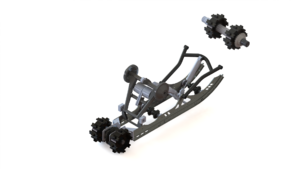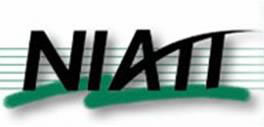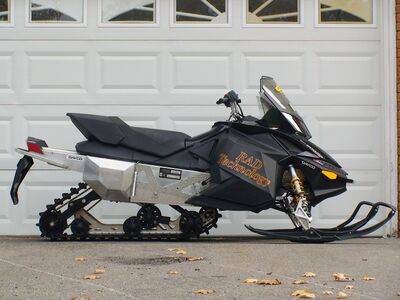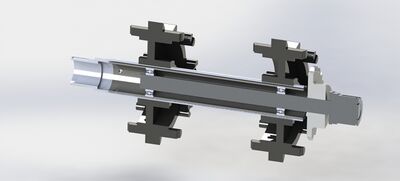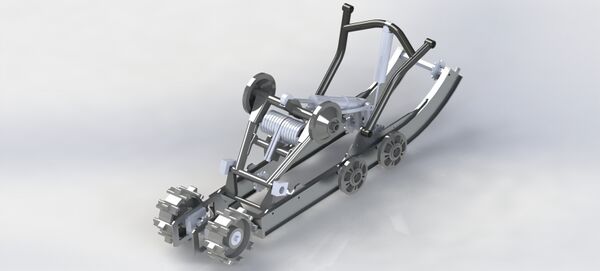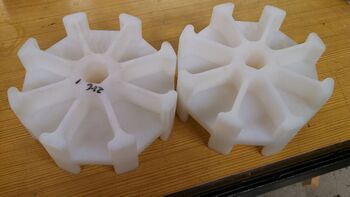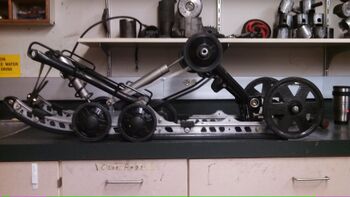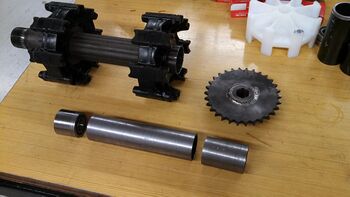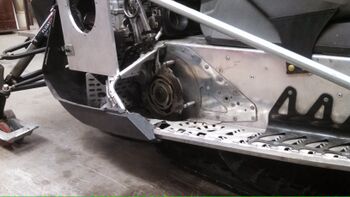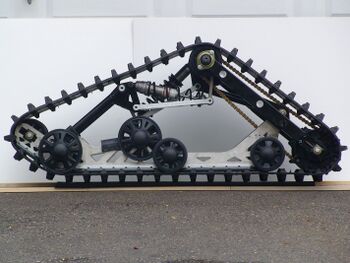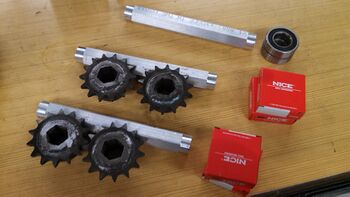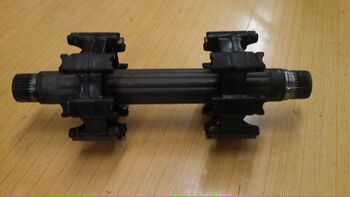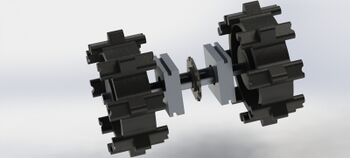CSC rear drive
| Team Powder Train CSC Rear drive design. | |
| Sponsors | |
| Team Name | Powder Train |
| Duration | Summer - Fall 2013 |
| Faculty Advisers |
|
| Mentor |
|
CSC rear drive is a project to modify the drive system of a Ski-Doo Snowmobile currently used by the University of Idaho Clean Snowmobile Challenge Project. The goal of this project is to relocate the drive axle and wheels from the front end of the snowmobile track to the back end of the snowmobile track. It is believed that this configuration will increase efficiency and power output of the snowmobile; a portion of this project will be dedicated to testing the veracity of this hypothesis. This project is generously sponsored by the National Institute for Advanced Transportation Technology (NIATT) at the University of Idaho through the CSC team.
Background
Clean Snowmobile Challenge
The SAE Clean Snowmobile Challenge is an "...engineering design competition for college and university student members that challenge engineering students to reengineer an existing snowmobile to reduce emissions and noise." The University of Idaho has had a CSC team participating in the challenge since 2001.
Rear drive concept
An enterprising snowmobile drag-racer by the name of Shawn Watling designed a rear drive system for snowmobiles that is claimed to deliver a 72 percent increase in fuel economy. Watling's design requires substantial modification a snowmobile's chassis. Hoping to incorporate this considerable improvement in efficiency into the University of Idaho CSC snowmobile, Team Powder Train has been charged with the design of a rear drive system that does not require any modification of the chassis, as any modification would violate the CSC competition rules.
About Team Powder Train
The team working on the rear drive project,Team Powder Train, is composed of University of Idaho students Zoltan Kiss, Josh Dalton, and Aaron Patterson.
Zoltan Kiss
Zoltan is a native of Troy, Idaho. A family man and a US Army veteran, Zoltan studied at North Idaho College in 2009 and came to the University of Idaho study mechanical engineering in 2010. He is a senior and will be graduating with a degree as a Bachelor of Science in Mechanical Engineering in December 2013.
Josh Dalton
Josh is a native of Deary, Idaho and came to the University of Idaho after serving a two year LDS mission in Brazil. While working on a bachelors degree in Mechanical Engineering he was also a member of the WAC indoor/outdoor Championship winning track team. He is a senior and will be graduating with a degree as a Bachelor of Science in Mechanical Engineering in December 2013.
Aaron Patterson
Aaron is a native of Rexburg, Idaho and came to the University of Idaho to study Mechanical Engineering after completing an enlistment in the United States Marine Corps in 2009. He is a senior and will graduate with a degree as a Bachelor of Science in Mechanical Engineering in May, 2014.
Problem Statment
Problem
The goal of the CSC team is to continually improve the efficiency of their snowmobiles. During normal operation, a snowmobile in a standard front-drive configuration could experience loose track bunching underneath the suspension rails because of the drive wheels pulling the track across the top of the suspension and pushing the track underneath the rails. This is hypothesized to lead to unnecessary friction and energy losses under the rails.
Objective
Team Powder Train was given the task of designing and building a prototype rear drive system for one of the CSC team's snowmobiles, designing a test apparatus and testing the rear drive to determine if the rear drive configuration does improve the efficiency of the snowmobile.
Specifications
The goals of the project are motivated and limited by the requirements of the CSC team.
- System instillation
- bolt-in design
- OEM apperance
- no chassis modification
- Weight
- no greater than 25% weight increase
- Fuel economy
- reduce the fuel consumed by increasing efficiency in the drive train
- Efficency
- increase percentage of engine power translated into movement
- decrease power losses in the track system
- Noise
- do not increase noise
- reduce noise if possible
- Handling
- Improve turning by taking slop out of the track
- Shorten stopping and starting distances
Project Learning
Prior UofI design
A prior University of Idaho senior design team designed a snowmobile rear drive for the CSC team but the design failed to satisfy all the client requirments. The design worked as a proof of concept, but with a weight of over 90 pounds was more than twice the weight of the stock suspension system. The system utilized a drive chain to transfer power. The design incorporated redesigned suspension which turned out to be inadequate and prone to damage during operation. The design did improve handling, and while it's unknown exactly why it is hypothesized that in addition to taking slop out of the track, the design lowered the snowmobiles center of gravity.
RND Innovators design
The RND Innovators rear drive design is a fully developed, unique rear drive system, although it doesn't appear to be commercially available at this time. This design requires extensive modification of the chassis of the snowmobile, which is not an option for the University of Idaho CSC team as chassis modification violates the CSC competition rules. The design does have purported advantages of shorter stopping distances, better handling, better acceleration, and significant improvements in fuel consumption over the stock configuration. Some of these advantages may be achieved through the redistribution of weight front to rear.
Design Challenges
The design hurdles faced in developing a snowmobile rear drive are various. Challenges include where to put the rear drive wheels, what form those wheels should take, whether or not to use the stock track configuration, where to put the brake, what type of drive train to use, and how to fit that drive train into the snowmobile, among others.
Drivetrain
One of the primary considerations in the design challenge is the type of drive train to use to transfer engine power to the rear drive. Options considered were electrical, hydraulic, drive shaft, belt drive, and chain drive. Electrical was a violation of competition rules and was dropped early. Hydraulic was a favored concept but the necessary equipment turned out to be too expensive and too heavy to be practical. A drive shaft was considered impractical due to obstructions and flexibility in the suspension and the need for differentials. A drive belt was considered impractical due to the environmental considerations of snow and ice on the belt. The team ultimately decided that the previously attempted chain drive option was the best choice for the application. It was determined that a drive chain system could probably be fit in among the stock suspension system.
Rear drive axle and wheels
The stock configuration of the snowmobile has bogey wheels in the rear that are adjustable to apply tension to the track so replacing those wheels required a way of either adjusting the axle or moving the tension equipment elsewhere. Also important was the fact that the drive wheels, due to the design of the stock track, line up with the rails in the suspension and a way would have to be found to either work around the rails or modify the rails to work around the drive wheels. This brought up the question of whether the idea of using a custom track should be considered, since doing so would allow for the placement of the drive wheels elsewhere. The CSC competition rules include guidelines concerning modifying parts or using non-standard parts for nearly everything on the snowmobile and using a custom track would certainly not be OEM so that option was ultimately rejected. A multi-part drive wheel was considered but would have required a great deal of complexity so it was decided that altering the rails and using standard drive wheels was the best option. The previous U of I team also modified their rails but chose to move them outboard, apparently to accommodate the brake they installed on the rear axle. This outboard configuration presented the problems of a weakly supported drive axle, a robust and heavy bracket to support the axle and the width of this system was greater than the track width, making it vulnerable to strikes from external objects. The team decided to move the rails inboard to provide better stability and deal with the brake in other ways. The tension system decided upon is virtually the same as stock except the rear axle will incorporate more robust bearings than would be in simple bogey wheels.
Brake
The stock brake is a hydraulic caliper and disc brake attached directly to the end of the front drive axle and stops the snowmobile through the drive wheels, which engage directly with the track. In order to keep weight down the team decided to keep this brake in place but with the front drive axle disconnected from the drive train to that when the brake is applied it can still stop the snowmobile but isn't fighting with the drive train. however, power has to be transferred through the area of the front drive axle so the idea of a two part axle was put forward. The two parts would be connected and rotate on the same axis but would have bearings separating them so they can move independently and without interference.
Design Alternatives
Hydrostatic Drive
The hydrostatic drive is a concept that actually was implemented commercially, though not successfully. Using this drive system the engine would drive a hydraulic pump and the flow it produced would drive a hydraulic motor attached to the rear axle. Initially this idea looked very promising, but this system has a disadvantage in that the weight of the equipment required is related to the amount of power transmitted. The commercial attempt to implement this system failed partially because the engine on the snowmobile produced very little power. The engines of the CSC team snowmobiles produce considerable horsepower and as a consequence the hydraulic equipment required would be far too heavy to be practical.
Drive Shaft
This design concept involved running a drive shaft from the chain case or the front driving axle to the rear driving axle. This design was determined to be impractical because there is no room for a drive shaft in the stock suspension of the snowmobile and the suspension system is complex enough that it would be impractical to try to re-design it around a drive shaft.
Belt drive
The belt drive concept revolved around the idea of transferring power from the front axle to the rear axle using a drive belt. This concept was rejected on the basis that a belt would have trouble with slipping once it began to accumulate ice and snow during operation because there would be no good way to shield the belt from the environment due to space restrictions.
Chain Drive
The chain drive concept is similar to the belt drive concept except it requires the use of drive chains instead of drive belts. This is the concept implemented by the previous design team. When weighed against the other options and the project requirements, this idea was determined to be the best concept.
Design Implementation
Final Concept
The final design selected was the chain drive concept. This design uses a specially designed front axle to transfer power from the snowmobile's chain-case to a drive-chain which then transfers power through a series of intermediate axles to the rear axle. The rear axle has drive wheels which drive the track.
Front Axle
The front axle is a modified stock drive axle. This axle is a two part axle with an inner and outer axle. The outer axle is the stock axle with its chain-case end cut off. The inner axle is a custom built part which is inserted into the cut off end of the outer axle and spins on a common axis. There are bearings between the outer and inner axle which allow them to spin independently, enabling braking which does not interfere with the drive-train.
Rails
The stock suspension rails have been replaced with custom built rails which are taller than the stock rails. The extra space provided by the taller rails allows space for the intermediate axles and their corresponding sprockets. The rails also have an assembly built on to the rear to accommodate the rear drive axle. These assemblies go from the rails to the inside of the drive wheels, unlike the previous design which went from the rails to the outside, making the assembly wider than the track and therefore vulnerable to striking foreign objects during operation.
Rear Axle
The rear axle is driven by a sprocket at its center and unlike the stock drive axle and previous designs is not connected to the braking system so is only as wide as the drive wheels. The rear axle has its bearings mounted in sliding housings which allow the track tension to be adjusted.
Testing
The system for testing the design consists of an electric motor mounted in place of the snowmobile's secondary clutch and a track dyno. The electric motor is capable of variable, and relatively precise, output. The snowmobile will be placed on the dyno to measure the track output. The snowmobile will be run, by the electric motor, with the stock suspension and drive system in place as a reference. The snowmobile will then be run with the rear drive system installed and the output from the two configurations will be compared.
Document Archive
| Presentations and reports | Design development |
|---|---|
|
File:EXPO poster CSC rear drive, new render.pdf EXPO poster. |
Failure mode analysis. |
|
File:PowderTrainTechSession Presentation CSCRearDrive.pdf Final presentation. |
File:Decision matrix, feasibility analysis.pdf Design concepts decision matrix. |
|
File:CSC Rear Drive Final Report - Powder Train2.pdf Final report |
Model, max torque.
|
Photos
|
Rear drive wheels. |
Brake location on previous UofI design. |
Standard suspension and rail configuration. |
|
Front axle parts, excluding the inner shaft. |
Location of stock brake system. |
RND Innovators suspension. |
|
Intermediate axles with sprockets and bearings. |
Stock front drive axle. |
Rear axle concept. |
External Links
RND Innovators website
http://www.rndinnovators.com/
NIATT website
http://www.webpages.uidaho.edu/niatt/
U of I CSC Team website
http://www.uiweb.uidaho.edu/uicsc/home.html
Popular Science rear drive article
http://www.popsci.com/diy/article/2010-05/invention-awwards-faster-safer-snowmobiling
